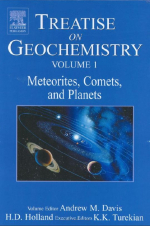Добрый день, Коллеги. Важное сообщение, просьба принять участие. Музей Ферсмана ищет помощь для реставрационных работ в помещении. Подробности по ссылке
Treatise on Geochemistry. Volume 1. Meteorites, comets and planets / Фундаментальный трактат по геохимии. Часть 1. Метеориты, кометы, планеты
Treatise on Geochemistry это первая в своем роде работа, с глобальным интегрированным подходом к современному состоянию Геохимии. В Трактате освещены все основные разделы геохимии, от химии солнечной системы, до экологической геохимии. В Treatise on Geochemistry использованы труды выдающихся мировых ученых и включены ссылки на самые современные публикации. Труд включает в себя 9 томов, каждый из которых состоит из 15-25 разделов, составленных ведущими авторитетами в данной области знаний. Treatise on Geochemistry в электронном формате включает в себя систему разветвленных ссылок, облегчающих навигацию по документу.
Nucleosynthesis is the study of the nuclear processes responsible for the formation of the elements which constitute the baryonic matter of the Universe. The elements of which the Universe is composed indeed have a quite complicated nucleosynthesis history, which extends from the first three minutes of the Big Bang through to the
present. Contemporary nucleosynthesis theory associates the production of certain elements isotopes or groups of elements with a number of specific astrophysical settings, the most significant of which are: (i) the cosmological Big Bang, (ii) stars, and (iii) supernovae. Cosmological nucleosynthesis studies predict that the conditions characterizing the Big Bang are consistent with the synthesis only of the lightest elements: 1H, 2H, 3He, 4He, and 7Li (Burles et al.,
2001; Cyburt et al., 2002). These contributions define the primordial compositions both of galaxies and of the first stars formed therein. Within galaxies, stars and supernovae play the dominant role both in synthesizing the elements
from carbon to uranium and in returning heavyelementenriched matter to the interstellar gas from which new stars are formed. The mass fraction of our solar system (formed,4.6 Gyr ago) in the form of heavy elements is,1.8%, and stars formed today in our galaxy can be a factor 2 or 3 more enriched (Edvardsson et al., 1993). It is the processes of nucleosynthesis operating in stars and supernovae that we will review in this chapter.We will confine our attention to three broad categories of stellar and supernova site with which specific nucleosynthesis products are understood to be identified: (i) intermediate mass stars, (ii) massive stars and associated type II supernovae, and (iii) type Iamsupernovae. The first two of these sites are the straightforward consequence of the evolutionnof single stars, while type Ia supernovae are understood to result from binary stellar evolution.




